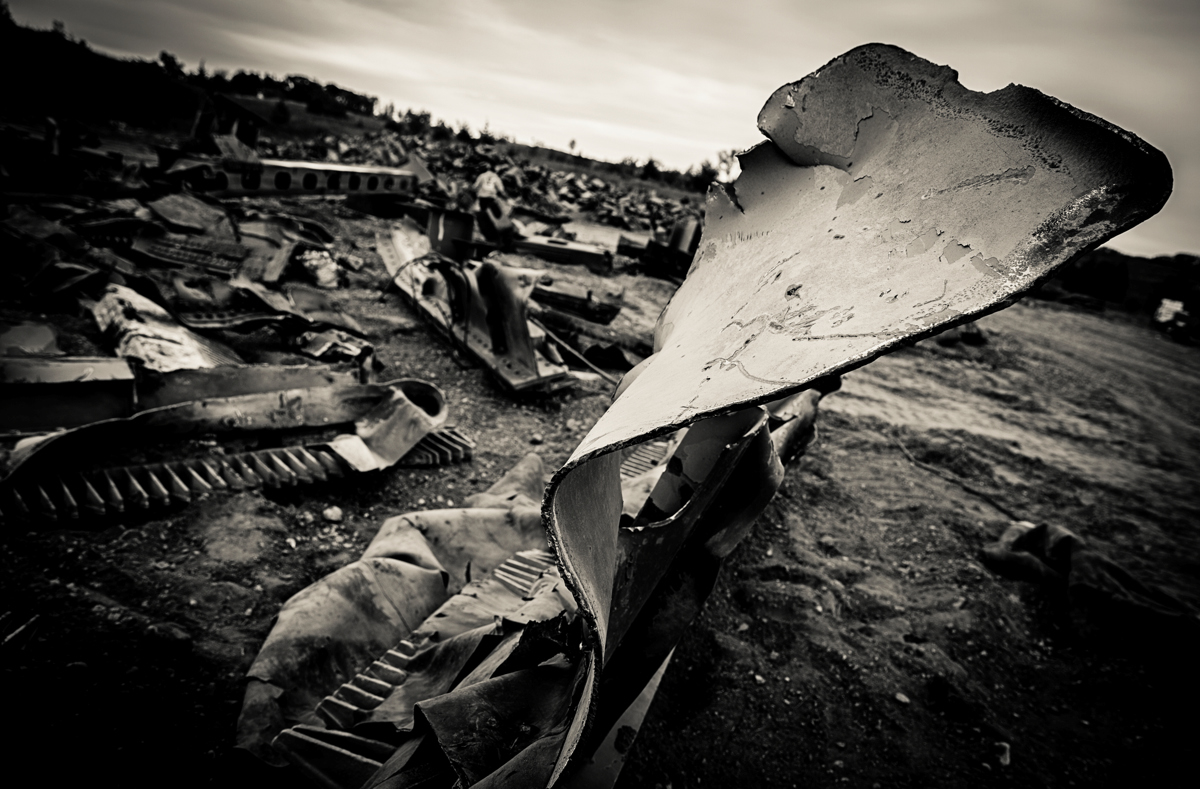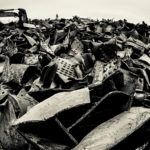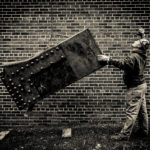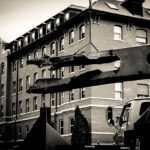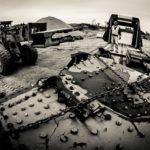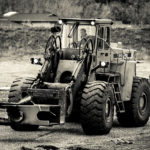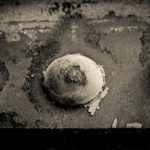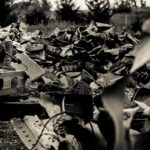It was Wednesday evening rush hour. People were heading into and home from downtown Minneapolis across the 1,907-foot-long bridge spanning the Mississippi River. Four of the eight-lanes were closed for a scheduled 7 p.m. concrete pour intended to make the bridge stronger and safer. The weight of the construction equipment – 578,735 pounds – proved deadly.
At 6:05 p.m., it all fell down. A thousand feet of deck truss collapsed as 456 feet of the main span hit the water. One hundred and ten vehicles tumbled into the 15-foot-deep river and its banks. It was Aug. 1, 2007, and the I-35W bridge had just collapsed.
Today 12,000 pounds of steel from the bridge reside on the St. Thomas campus as a reminder of that day – a reminder to future engineers that the things they design and create always have a direct impact on others, for better or worse.
The three pieces of the bridge now in St. Thomas’ care are especially significant; they come from a section called the U10W, which is a gusset plate from the north end of the bridge. The plate is the sister piece of the one that failed on the south end of the bridge and is believed to have set off the bridge collapse. The Minnesota Historical Society possesses that plate, but according to Don Weinkauf, dean of the School of Engineering, the piece St. Thomas has is enough to “tell much of the story of how the whole tragedy unfolded."
“Just seeing this metal torn like taffy – it’s a very powerful example of the forces that were at play that day,” Weinkauf said.
The piece also will serve as a sobering reminder of a collapse that killed 13 and injured 145. “The installation will serve as a memorial as well. We want to firmly embed in the minds of our students that things that they design, create and build will touch people’s lives,” Weinkauf said.
St. Thomas acquired the pieces in October, though Weinkauf initially had requested them in the fall of 2008 from the Minnesota Department of Transportation. The long wait was a result of pending litigation for the distribution of the pieces. The legislation passed in early May, delineating the order of selection: Victims first, then other organizations and schools, while the rest would be recycled at a Wisconsin steel mill, whose largest product is cars. In addition to St. Thomas, engineering programs at the University of Minnesota and Purdue University received pieces.
Looking ahead, the School of Engineering will reassemble the steel pieces – now laying behind Brady Educational Center – in a roughly 12-feet-wide by 8-feet-tall installation near the Frey Science and Engineering Center. “They’ll still be broken apart, but you’ll get some sense of what the original structure looked like before being torn apart,” Weinkauf said.
Why the bridge fell down
The I-35W bridge was designed by Sverdrup & Parcel and Associates Inc. Construction started in 1964, and the bridge opened to traffic in 1967. It was built as a truss deck bridge, of which the average life span is 50 years. It was a popular, economical design, with the trusses providing strength and stability, and the deck laid on top. By 2007, the bridge carried more than 140,000 vehicles daily. Yet even as roadway work was being done to improve the bridge, even as the Civil Engineering Department at the University of Minnesota was monitoring the bridge with stress sensors, the I-35W bridge went down.
Though many theories were proposed for the bridge’s failure, the National Transportation Safety Board (NTSB) determined that the probable cause of the collapse was the inadequate load capacity, due to a design error by Sverdup & Parcel, of the gusset plates at the U10 nodes. The plates failed because of substantial increases in the weight of the bridge from previous bridge modifications, and the traffic and concentrated construction loads on the bridge on the day of the collapse. A contributing factor was inadequate quality control.
Katherine Acton, assistant professor in engineering, said one of the lessons to take away from the collapse is the collaborative nature of any large design project. “You have engineers who work on the drawings and put things on the computer. And then you have to translate that knowledge to a set of people who are actually going to build the structure. Part of the issue with the I-35W bridge was that it was resurfaced and there was no communication,” Acton said.
Though the collapse was disastrous, it yielded nine recommendations from the NTSB to improve the safety of bridges across the country.
“They include things such as better quality control processes for gusset plates, better quality control for inspection, new tools, new processes for informing contractors on how to place construction loads onsite. Very real-world changes,” said Deborah Besser, an adjunct instructor in engineering and director of the Center for Pre-Collegiate Engineering Education at St. Thomas.
Acton said a majority of Americans are not aware of the state of a large part of the country’s infrastructure: “We have aging infrastructure; bridges may not be as safe as we think they are.”
According to Besser, the American Society of Civil Engineers 2013 Report Card for America’s infrastructure rated it a D+. “I don’t know that that hits home with the public until they see a failure like this,” Besser said.
Lessons learned
The pieces offer “tremendous lessons to be learned,” according to Weinkauf. “Students are studying these systems in class, but it’s almost impossible to understand them without seeing something on this scale.” The pieces will physically show the students what happened and allow opportunities for case studies and engineering analyses.
Acton said the Statics and Mechanics of Materials courses in the engineering curriculum lend themselves well to integrating some of these lessons. “In Statics, we look at the forces on things, and in Mechanics we look at how the materials really respond to those forces in terms of deformation and failure,” Acton said. The plan for Mechanics in spring 2014 is to “come up with some sort of lab experience where students actually get to look at the bridge, analyze what happened and analyze the modes of failure.”
St. Thomas offers bachelor’s and master’s programs in mechanical and electrical engineering, and while there is no civil engineering department, faculty such as Acton and Besser are working on ways to develop a path for students to go into civil engineering and get their Professional Engineer (PE) license.
Ben Stassen, a senior mechanical engineering major, might not be around to see curriculum changes, but said the I-35W bridge collapse has made him think differently about engineering. “I’ve decided to pursue my PE and I may very well be working with professional plans and drawings, so it could be my responsibility one day to prevent something similar from happening,” Stassen said.
Better bridges, better world
While accidents such as the I-35W bridge collapse devastate the nation, they also give engineers an opportunity to learn a hard lesson from prior mistakes and continue to improve infrastructure.
St. Thomas students may look upon the remains of the I-35W bridge – a “piece of history” as Stassen sees it – as both a learning tool and a memorial for everyone, not just engineers.
“There’s this gut reaction to seeing the tangible pieces and literally being able to run your hand over them, and then think about the consequences,” Besser said.
According to Acton, the pieces will stand as “a symbol for everything that we’re trying to accomplish here to avert disasters like this in the future. ... It’s a piece of our state’s history that we now are the caretakers of and we really take that responsibility and privilege seriously.”
As engineering majors graduate this spring, they will take an oath and receive signature rings for their induction into the Order of the Engineer, an association for engineers to remind themselves of a solemn obligation to serve society through their work. According to legend, the first rings were made from the twisted steel of a collapsed Canadian bridge, and members wear a steel pinky ring on their signature hand.
St. Thomas students also will take with them lessons from a broken bridge that collapsed a little closer to home.
Read more from St. Thomas magazine.
